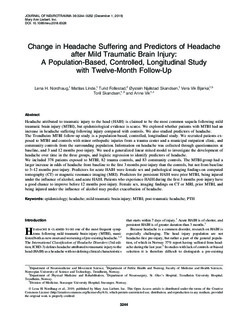| dc.contributor.author | Nordhaug, Lena Hoem | |
| dc.contributor.author | Linde, Mattias | |
| dc.contributor.author | Follestad, Turid | |
| dc.contributor.author | skandsen, øystein njølstad | |
| dc.contributor.author | Bjarkø, Vera Vik | |
| dc.contributor.author | Skandsen, Toril | |
| dc.contributor.author | Vik, Anne | |
| dc.date.accessioned | 2020-01-13T13:01:31Z | |
| dc.date.available | 2020-01-13T13:01:31Z | |
| dc.date.created | 2020-01-09T10:03:45Z | |
| dc.date.issued | 2019 | |
| dc.identifier.citation | Journal of Neurotrauma. 2019, 36 (23), 3244-3252. | nb_NO |
| dc.identifier.issn | 0897-7151 | |
| dc.identifier.uri | http://hdl.handle.net/11250/2635997 | |
| dc.description.abstract | Headache attributed to traumatic injury to the head (HAIH) is claimed to be the most common sequela following mild traumatic brain injury (MTBI), but epidemiological evidence is scarce. We explored whether patients with MTBI had an increase in headache suffering following injury compared with controls. We also studied predictors of headache.
The Trondheim MTBI follow-up study is a population-based, controlled, longitudinal study. We recruited patients exposed to MTBI and controls with minor orthopedic injuries from a trauma center and a municipal outpatient clinic, and community controls from the surrounding population. Information on headache was collected through questionnaires at baseline, and 3 and 12 months post-injury. We used a generalized linear mixed model to investigate the development of headache over time in the three groups, and logistic regression to identify predictors of headache.
We included 378 patients exposed to MTBI, 82 trauma controls, and 83 community controls. The MTBI-group had a larger increase in odds of headache from baseline to the first 3 months post-injury than the controls, but not from baseline to 3–12 months post-injury. Predictors for acute HAIH were female sex and pathological imaging findings on computed tomography (CT) or magnetic resonance imaging (MRI). Predictors for persistent HAIH were prior MTBI, being injured under the influence of alcohol, and acute HAIH. Patients who experience HAIH during the first 3 months post-injury have a good chance to improve before 12 months post-injury. Female sex, imaging findings on CT or MRI, prior MTBI, and being injured under the influence of alcohol may predict exacerbation of headache. | nb_NO |
| dc.language.iso | eng | nb_NO |
| dc.publisher | Mary Ann Liebert | nb_NO |
| dc.rights | Navngivelse 4.0 Internasjonal | * |
| dc.rights.uri | http://creativecommons.org/licenses/by/4.0/deed.no | * |
| dc.title | Change in Headache Suffering and Predictors of Headache after Mild Traumatic Brain Injury: A Population-Based, Controlled, Longitudinal Study with Twelve-Month Follow-Up | nb_NO |
| dc.type | Journal article | nb_NO |
| dc.type | Peer reviewed | nb_NO |
| dc.description.version | publishedVersion | nb_NO |
| dc.source.pagenumber | 3244-3252 | nb_NO |
| dc.source.volume | 36 | nb_NO |
| dc.source.journal | Journal of Neurotrauma | nb_NO |
| dc.source.issue | 23 | nb_NO |
| dc.identifier.doi | 10.1089/neu.2018.6328 | |
| dc.identifier.cristin | 1769025 | |
| dc.description.localcode | Lena H. Nordhaug et al., 2019; published by Mary Ann Liebert, Inc. This Open Access article is distributed under the terms of the Creative Commons License (http://creativecommons.org/licenses/by/4.0), which permits unrestricted use, distribution, and reproduction in any medium, provided the original work is properly credited. | nb_NO |
| cristin.unitcode | 194,65,30,0 | |
| cristin.unitcode | 194,65,20,0 | |
| cristin.unitcode | 1920,0,0,0 | |
| cristin.unitname | Institutt for nevromedisin og bevegelsesvitenskap | |
| cristin.unitname | Institutt for samfunnsmedisin og sykepleie | |
| cristin.unitname | St. Olavs Hospital HF | |
| cristin.ispublished | true | |
| cristin.fulltext | original | |
| cristin.qualitycode | 1 | |

